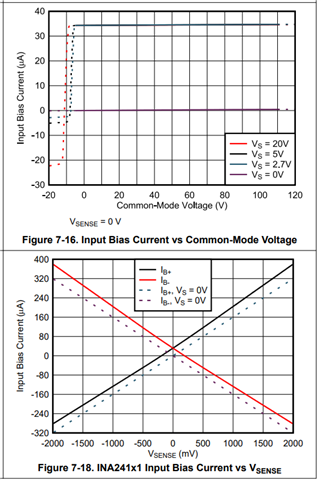Other Parts Discussed in Thread: INA241A, INA190
Dear Technical Support Team,
I have been searching -2V VCM capable similar to INA186.
Could you introduce it?
Rsense=82Ω and bidirectional.
Best Regards,
ttd
This thread has been locked.
If you have a related question, please click the "Ask a related question" button in the top right corner. The newly created question will be automatically linked to this question.
ttd,
Thanks for using E2E.
Specifically what about the INA186 are you hoping to maintain here (low Ib, price point, etc)? Unfortunately, to achieve a common mode of substance into the negative region voltage, this requires additional circuitry internal to the silicon, and therefore usually comes at an increased price point. You can view the list of devices that meet this common mode specification here, but none of them are going to possess the bias currents that the INA186 has.
Hi Carolus Andrews,
Thank you for your reply.
I'm investigating INA241A 1(gain=20). How is the input impedance for this?
Shunt resistance is around 100Ω for 1mA, so high-impedance is better.
According to previous E2E, is input impedance MΩ estimated from "Iinput Bias Current vs Common-Mode Voltage" ?

Best Regards,
ttd
ttd,
Yes, you can derive common mode and differential input impedance from the slopes of these corresponding graphs. Check out this blog, as it shares a bit about this topic and the challenges you may face for this application.
Can you share what the total measurement range you are looking to measure here is? You mention 1mA, but is this the upper end or lower end of the current range you are looking to measure here?
Hi,
Thank you for your reply, blog is useful for me.
Total measurement range is from 1mA(max) and -1mA(min) on high side with 80~100Ω shunt.
So high impedance is required on input for appropriate measurement.
Best Regards,
ttd
ttd,
Understood. Given the impedance needs here, as well as the common mode requirement, the only solution I could potentially recommend would be that you could potentially run the device in split supply. This would require to use a package with a reference pin, referred to GND, and then place Vs and GND at -2.5V and 2.5V respectively. By placing GND at -2.5V, you would effectively shift the common mode voltage curve down along with the GND where -2V would be inside the valid common mode range as per the recommended and maximums tables. You can run most of our devices in split supply mode, but we only characterize single supply mode.
Alternatively, you may find other solutions looking into instrumentation amplifiers products. Unfortunately, there are no other current sense amplifiers similar to the INA186/INA190 that support the negative common mode range you need here.